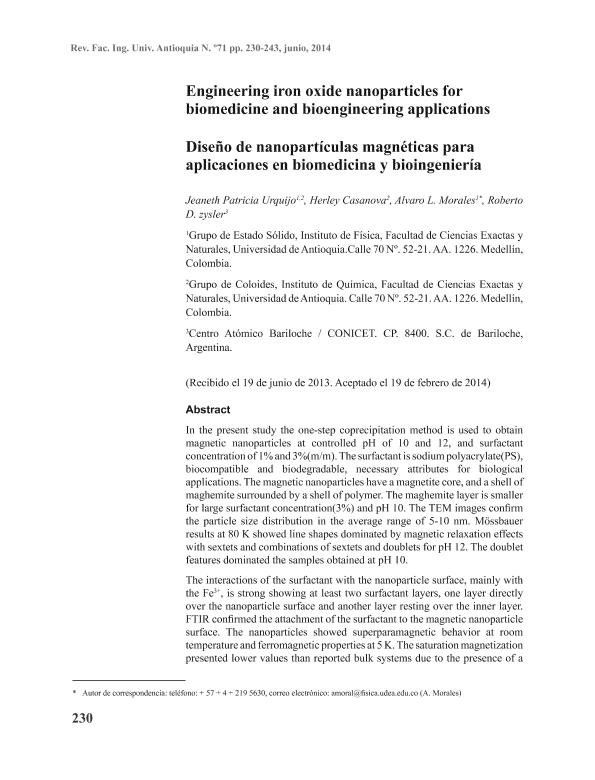Mostrar el registro sencillo del ítem
dc.contributor.author
Urquijo, Jeaneth Patricia
dc.contributor.author
Casanova, Herley
dc.contributor.author
Morales, Álvaro L.
dc.contributor.author
Zysler, Roberto Daniel

dc.date.available
2016-12-12T13:56:09Z
dc.date.issued
2014-06
dc.identifier.citation
Urquijo, Jeaneth Patricia ; Casanova, Herley ; Morales, Álvaro L. ; Zysler, Roberto Daniel; Engineering Iron Oxide Nanoparticles for Biomedicine and Bioengineering Applications; Imprenta Univ Antioquia; Revista Facultad de Ingeniería Universidad de Antioquia; 71; 6-2014; 230-243
dc.identifier.issn
0120-6230
dc.identifier.uri
http://hdl.handle.net/11336/9085
dc.description.abstract
In the present study the one-step coprecipitation method is used to obtain magnetic nanoparticles at controlled pH of 10 and 12, and surfactant concentration of 1% and 3%(m/m). The surfactant is sodium polyacrylate(PS), biocompatible and biodegradable, necessary attributes for biological applications. The magnetic nanoparticles have a magnetite core, and a shell of maghemite surrounded by a shell of polymer. The maghemite layer is smaller for large surfactant concentration(3%) and pH 10. The TEM images confirm the particle size distribution in the average range of 5-10 nm. Mössbauer results at 80 K showed line shapes dominated by magnetic relaxation effects with sextets and combinations of sextets and doublets for pH 12. The doublet features dominated the samples obtained at pH 10. The interactions of the surfactant with the nanoparticle surface, mainly with the Fe3+, is strong showing at least two surfactant layers, one layer directly over the nanoparticle surface and another layer resting over the inner layer. FTIR confirmed the attachment of the surfactant to the magnetic nanoparticle surface. The nanoparticles showed superparamagnetic behavior at room temperature and ferromagnetic properties at 5 K. The saturation magnetization presented lower values than reported bulk systems due to the presence of a large layer of maghemite. The very close particle size for all samples gave indication that the particle growth was dominated by the surface properties of the nanoparticles and that the pH and surfactant concentration did not affect importantly the growth process.
dc.description.abstract
Se usó el método de coprecipitación en un solo paso controlando el pH a 10 y 12 y en concentraciones de poliacrilato(PS) de 1% y 3%(m/m). El surfactante es biocompatible y biodegradable, atributos necesarios para su uso en aplicaciones biológicas. Las nanopartículas magnéticas están formadas por una coraza interna de magnetita, una capa de maghemita y una capa externa del polímero. La capa de maghemita es pequeña para la concentración de 3% y pH 10. Las imágenes de TEM confirman la distribución de tamaños de partícula en el rango promedio de 5-10 nm. Los resultados Mössbauer a 80 K mostraron formas de línea dominadas por efectos de relajación magnética en forma de sextetos y combinanciones de sextetos y dobletes; estos dominaron a pH 10. Las interacciones del polímero con la superficie de las nanopartículas, principalmente con el Fe3+, es fuerte mostrando al menos dos capas del polímero sobre ellas. Las medidas magnéticas muestran un comportamiento superparamagnético a temperatura ambiente y ferrimagnético a 5 k. La magnetización de saturación presentó valores menores que las repotadas para volúmenes grandes debido a la caapa de maghemita presente. El tamaño de partícula obtenido para todas las muestras es muy cercano entre si indicando que el crecimiento de las partículas fue dominado por las propiedades de la superficie de estas y en menor grado por las condiciones de concentración y pH usadas.
dc.format
application/pdf
dc.language.iso
eng
dc.publisher
Imprenta Univ Antioquia

dc.rights
info:eu-repo/semantics/openAccess
dc.rights.uri
https://creativecommons.org/licenses/by-nc-sa/2.5/ar/
dc.subject
Magnetic Nanoparticles
dc.subject
Sodiumpolyacrilate
dc.subject
Mössbauer Spectroscopy
dc.subject
Thermo Magnetic Measurements
dc.subject
Ftir
dc.subject
Tem
dc.subject.classification
Física de los Materiales Condensados

dc.subject.classification
Ciencias Físicas

dc.subject.classification
CIENCIAS NATURALES Y EXACTAS

dc.title
Engineering Iron Oxide Nanoparticles for Biomedicine and Bioengineering Applications
dc.title
Diseño de nanopartículas magnéticas para aplicaciones en biomedicina y bioingeniería
dc.type
info:eu-repo/semantics/article
dc.type
info:ar-repo/semantics/artículo
dc.type
info:eu-repo/semantics/publishedVersion
dc.date.updated
2016-12-07T18:13:09Z
dc.journal.volume
71
dc.journal.pagination
230-243
dc.journal.pais
Colombia

dc.journal.ciudad
Medellín
dc.description.fil
Fil: Urquijo, Jeaneth Patricia . Universidad de Antioquia; Colombia
dc.description.fil
Fil: Casanova, Herley . Universidad de Antioquia; Colombia
dc.description.fil
Fil: Morales, Álvaro L. . Universidad de Antioquia; Colombia
dc.description.fil
Fil: Zysler, Roberto Daniel. Comision Nacional de Energia Atomica. Gerencia del Area de Investigaciones y Aplicaciones no Nucleares. Gerencia de Fisica (CAB); Argentina. Consejo Nacional de Investigaciones Científicas y Técnicas; Argentina
dc.journal.title
Revista Facultad de Ingeniería Universidad de Antioquia

dc.relation.alternativeid
info:eu-repo/semantics/altIdentifier/url/http://aprendeenlinea.udea.edu.co/revistas/index.php/ingenieria/article/view/15543
dc.relation.alternativeid
info:eu-repo/semantics/altIdentifier/url/http://ref.scielo.org/nh38qz
dc.relation.alternativeid
info:eu-repo/semantics/altIdentifier/url/http://www.redalyc.org/articulo.oa?id=43031204019
Archivos asociados
